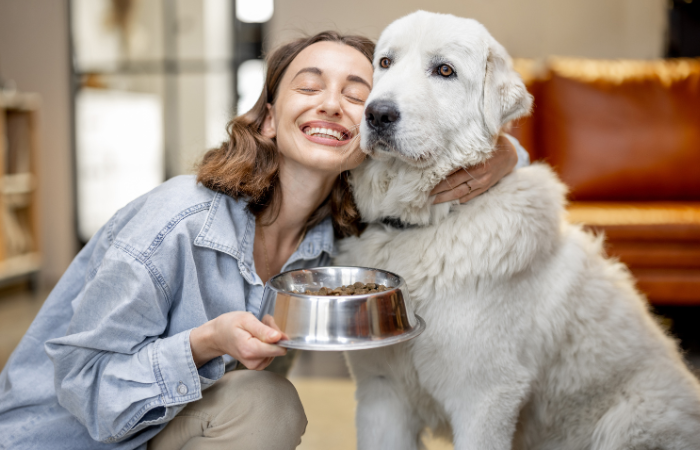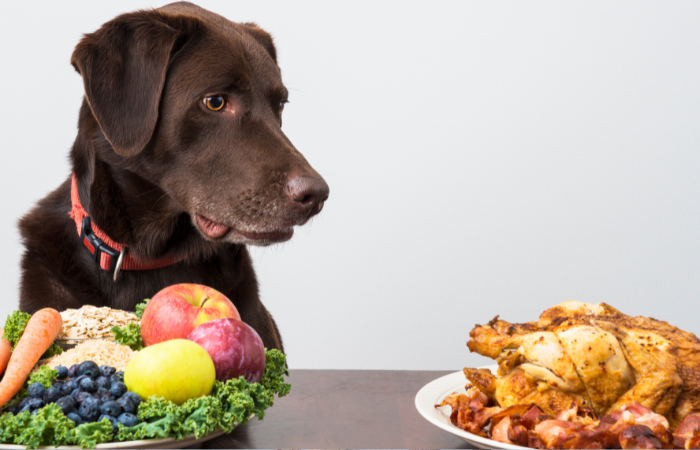Happy Tummy, Happy Pup: Simple Ways to Increase Fiber in Your Dog's Diet

Is your pet experiencing intestinal problems? Giving your dog more fiber in their diet is one of the finest methods to help with digestion. In addition to helping with digestion, fiber lowers the chance of developing certain diseases, encourages weight management, and avoids constipation.
Eating a diet richer in fruits and vegetables can boost intake of fiber. Pumpkin, green beans, and sweet potatoes are fiber-rich and flavorful and can be combined with high-fiber brown rice and oats. Chia and flaxseeds are high in fiber, so consider adding them too.
Although adding more fiber to your dog's diet might have many advantages, it's crucial to do so gradually to prevent any upset stomach. Prior to implementing any major dietary changes for your dog, always get advice from your veterinarian. Are you prepared to help your dog's digestive system? Let's explore these easy and efficient methods for giving your dog more fiber in their food to help them have a happy, healthy stomach.
Why is fiber crucial for canines?
For the general health of your dog, fiber is essential. Fiber cleans out waste and toxins from your dog's digestive tract like a broom. Fiber prevents diarrhea and constipation by regulating bowel motions. Additionally, fiber helps you feel full, which may aid in weight loss and help you refrain from overeating. Diets high in fiber help dogs avoid diabetes, obesity, and colon cancer. Fiber balances blood sugar and promotes digestive health, helping your pet live longer. Fiber may be especially beneficial for dogs with inflammatory bowel disease or anal gland issues. It reduces stomach issues and discomfort as well.

Symptoms of a dog's diet lacking in fiber
It's critical to recognize the warning indications that your dog may not be receiving enough fiber from their food. Digestion problems including constipation, diarrhea, or irregular bowel movements might result from a diet low in fiber. It could indicate that your dog isn't getting enough fiber if you see them straining during bowel motions or having loose stools.
A low-fiber diet may also contribute to weight gain or obesity. Dogs may overeat or demand for food all the time if they don't get the feeling of fullness that fiber gives. It can be worthwhile to think about giving your dog more fiber if they are gaining weight in spite of eating a balanced diet and getting frequent exercise.
Advantages of feeding your dog more fiber
Adding more fiber to your dog's food has many advantages. First of all, fiber facilitates regular bowel movements and gives the stool more volume, which helps with digesting. This can lessen the chance of gastrointestinal problems and help prevent constipation.
Fiber benefits dogs' digestive systems as well as their ability to control their weight. Dogs can eat fiber-rich foods without overeating since they have fewer calories. This is great for overweight or prone-to-gaining dogs. Providing dogs with fiber-rich kibble can also regulate blood sugar. Diabetes-prone or diabetic dogs need this. Fiber slows glucose absorption, reducing blood sugar rises and improving control.
How to calculate your dog's appropriate daily intake of fiber
Consider your dog's needs and medical conditions while determining their fiber intake. Talk to your vet about your dog's size, age, breed, and food. Two to four percent of dogs' daily calories should be fiber. Age, exercise level, and medical issues may affect this. To check your dog's fiber tolerance and to make adjustments, your doctor may recommend a specific fiber range or a gradual increase. Remember that too much fiber might cause gas or bloating. It's important to maintain a balance and avoid overusing fiber supplements.

Natural fiber sources for dogs
Add a high-fiber diet of fruits, vegetables, and grains to your dog's food to increase fiber intake. Good foods include green beans, pumpkin, and sweet potatoes, which are high in fiber. Healthy snacks, sautés, and purées can be produced from these vegetables. Be careful to remove any dog-harmful spices, seeds, or skins. Fiber-rich fruits are great for dogs. Apples, bananas, and blueberries are pet-friendly and nutritious. Remember that grapes and raisins are poisonous to dogs, so double-check before feeding them new fruits. You may boost your dog's fiber intake by feeding them brown rice and oats. These grains can be cooked into your dog's food or used to make homemade treats. Be sure to fully cook them and avoid unhealthy spices.
Adding foods high in fiber to your dog's diet
It's crucial to gradually introduce foods high in fiber to your dog's diet. It is advisable to start small and progressively increase the fiber level over time to avoid causing digestive upset due to abrupt dietary changes. This will reduce dog’s discomfort and give his digestive system time to adjust.
Start feeding your dog small amounts of high-fiber foods with their usual diet. You might add a teaspoon of pureed pumpkin or cooked sweet potatoes to their meal. Add high-fiber food slowly as your dog reacts. Remember that some dogs have allergies or need special diets. Consult your vet before feeding your dog anything new, especially if they have food allergies.

Homemade recipes and treats high in fiber for dogs
Make high-fiber dog treats to prepare or spice up your dog's diet. You can regulate the ingredients in homemade dog treats, so they're healthy and fit for their diet.
One easy high-fiber dog treat recipe is an oat-pumpkin biscuit. These delights are made with a pinch of flour, oats, and pumpkin puree. Roll and cut dough into biscuits. After baking until golden brown, let them cool before feeding your dog.
A stew made with vegetables and chicken is another dish concept. Cooked chicken, an assortment of veggies, such carrots and green beans, and a tiny bit of brown rice or oats can be combined to make this. Cook the mixture slowly until the flavors have combined and the vegetables are soft. You may portion it out and give it to your dog as a high-fiber meal once it has cooled.
Take care while adding more fiber to your dog's diet.
While adding more fiber to your dog's food can have many advantages, you should take some safety measures to guarantee their general wellbeing. The key to prevent any discomfort in the digestive system is to add fiber gradually. Gas, diarrhea, and bloating might result from suddenly increasing your fiber consumption.
See your veterinarian if your dog is experiencing any adverse effects or if he is struggling to adjust to the new, high-fiber food. For the purpose of enhancing your dog's digestive health, they might advise changing the fiber content or suggesting different strategies.
Your dog should have access to clean water at all times. High-fiber foods make you thirstier, so drink lots of water to stay hydrated and with digestion.

Supplementation of fiber for dogs
Your dog's physician might occasionally advise fiber supplements. Dogs who need more fiber in their diet or who have specific medical issues may benefit most from these supplements.
Dogs can get fiber supplements in the form of chews, tablets, and powders. Usually, they are manufactured from cellulose or psyllium husk which are naturally occurring forms of fiber. Depending on the particular product and the advice of your veterinarian, you can give these supplements alone or in addition to your dog's usual meal.
It's critical that you adhere to your veterinarian's recommendations about the amount and timing of fiber supplements. Giving your dog too much or too little might have negative consequences on their general health and digestive system.
Conclusion:
Adding more fiber to your dog's diet is an easy and efficient method to support improved digestive health. In addition to helping with digestion, fiber has many additional advantages, including helping people maintain their weight and preventing sickness.
You may provide your dog with the nutritional boost they require by adding foods high in fiber, such as fruits, vegetables, and grains, to their meals. Just keep in mind to gradually add fiber and see your veterinarian before making any big dietary adjustments for your dog.
You can make sure that your pet has a happy and healthy stomach for many years to come with a little bit of preparation and thought. Why then wait? Start feeding your dog more fiber right now, and you'll see them flourish!

